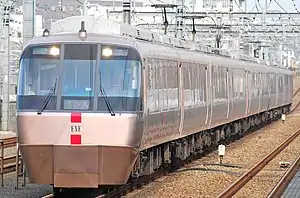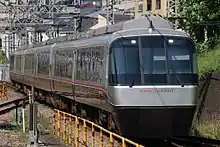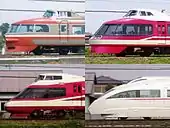Odakyu 30000 series EXE
The Odakyu 30000 series EXE (小田急30000形, Odakyū 30000-gata) ("Excellent Express") is an electric multiple unit (EMU) train type operated by the private railway operator Odakyu Electric Railway in Japan on Odakyu Odawara Line and Odakyu Enoshima Line "Romancecar" services since 1996.[1]
| Odakyu 30000 series EXE | |
|---|---|
 An Odakyu 30000 series EXE on the Odakyu Odawara Line | |
| Manufacturer | Nippon Sharyo |
| Family name | Romancecar |
| Constructed | 1996–1999 |
| Entered service | 1996 |
| Refurbished | 2016- |
| Number built | 70 vehicles (14 sets) |
| Number in service | 70 vehicles (14 sets) |
| Predecessor | Odakyu 3100 series NSE |
| Formation | 6+4 car sets |
| Operator(s) | Odakyu Electric Railway |
| Specifications | |
| Car length | 20,000 mm (65 ft 7 in) |
| Width | 2,900 mm (9 ft 6 in) |
| Floor height | 1,180 mm (3 ft 10 in) |
| Maximum speed | 110 km/h (70 mph) |
| Traction system | Variable frequency (IGBT, SiC-MOSFET (refurbished)) |
| Electric system(s) | 1,500 V DC |
| Current collection method | Overhead lines |
| Braking system(s) | Regenerative brake |
| Safety system(s) | D-ATS-P (OM) |
| Track gauge | 1,067 mm (3 ft 6 in) |
Design
Seven 4+6-car trainsets (70 vehicles) were built between 1996 and 1999 to replace ageing Odakyu 3100 series NSE trains.[1] Unlike earlier Romancecar trainsets, which used articulated carriages, the 30000 series sets have 20 m long bogie cars.[1] The inner driving cabs of the 4+6-car formations have gangway doors.[1]
The passenger doors use 800 mm (31 in) wide sliding doors, with 1,000 mm (39 in) wide doors on cars 2, 5, and 8 to provide wheelchair accessibility.[2]
 A 30000 series half-set with a gangwayed driving car leading in February 2004
A 30000 series half-set with a gangwayed driving car leading in February 2004 The gangwayed intermediate driving cars (cars 6 and 7)
The gangwayed intermediate driving cars (cars 6 and 7) The interior of a gangwayed driver's cab
The interior of a gangwayed driver's cab
Operations

The 30000 series trains are used on Odakyu Odawara Line Hakone services between Shinjuku in Tokyo and Hakone-Yumoto Station in Kanagawa Prefecture (about 88 km), as well as Sagami and Homeway services. They are also on Odakyu Enoshima Line Enoshima services between Shinjuku and Katase-Enoshima.[1]
Trainsets were introduced on combined Hakone and Enoshima services, with trains dividing at Machida, and later at Sagami-Ono.[2] 10-car Hakone services to Hakone-Yumoto also divide at Odawara with just the 6-car sets continuing onward to Hakone-Yumoto.[2]
Formations
As of 1 April 2016, the fleet consists of seven 4+6-car trainsets, formed as follows, with car 1 at the western end.[3] All seven sets are based at Ebina Depot.[3]
Unrefurbished sets
| Car No. | 1 | 2 | 3 | 4 | 5 | 6 | 7 | 8 | 9 | 10 | |
|---|---|---|---|---|---|---|---|---|---|---|---|
| Designation | Tc2 | M2' | T2 | T1 | M1' | Tc1' | Tc2' | M2 | M1 | Tc1 | |
| Numbering | 3055x | 3050x | 3045x | 3035x | 3020x | 3025x | 3015x | 3010x | 3000x | 3005x |
Cars 2, 3, 5, 8, and 9 are each fitted with a single-arm pantograph.[3] Only one bogie on car 9 is motored.[3]
Refurbished sets
Refurbished trainsets are formed as follows, with five motored cars per ten-car formation.[4]
| Car No. | 1 | 2 | 3 | 4 | 5 | 6 | 7 | 8 | 9 | 10 | |
|---|---|---|---|---|---|---|---|---|---|---|---|
| Designation | Tc2 | M3 | M2'N | T1 | M1' | Tc1' | Tc2' | M2 | M1 | Tc1 | |
| Numbering | 3055x | 3050x | 3040x | 3035x | 3020x | 3025x | 3015x | 3010x | 3000x | 3005x | |
| Weight (t) | 33.45 | 42.32 | 41.60 | 35.99 | 40.50 | 35.36 | 37.02 | 42.45 | 41.44 | 33.56 | |
| Capacity | 56 | 58 | 56 | 68 | 54 | 60 | 58 | 58 | 54 | 56 |
Cars 2, 3, 5, 8, and 9 are each fitted with a PT7113-A single-arm pantograph.[4]
Interior
Passenger accommodation consists of monoclass unidirectional 2+2 abreast seating, with 460 mm (18 in) wide seats and a seating pitch of 1,000 mm (39 in).[4] The first eight half-sets delivered had green-coloured seats in the six-cars sets (evoking the forests of Hakone) and blue-coloured seats in the four-car sets (evoking the sea of Enoshima), but from 1999 onward, the seats in all sets was standardized with grey and brown seat covers.[2] Wheelchair spaces are located in cars 5 and 8.[3]
Refreshment counters are provided in cars 3 and 9.[2] Toilets are provided in cars 2, 5, and 8, and the toilet in car 5 is a universal access type.[2]
 The passenger saloon interior in March 2007
The passenger saloon interior in March 2007 Seating in March 2007
Seating in March 2007 A refreshment counter in November 2011
A refreshment counter in November 2011
History
The first trains entered revenue service on 23 March 1996.[2]
Build history
The fleet was built between 1996 and 1999 in three batches as follows.[2]
| Batch | Sets | Build date |
|---|---|---|
| 1st | 1-2 | January - February 1996 |
| 2nd | 3-4 | April - May 1997 |
| 3rd | 5-7 | April - June 1999 |
Refurbishment

The fleet is scheduled to undergo a programme of refurbishment from fiscal 2016, with the first 4+6-car trainset treated returning to service in March 2017, rebranded "EXEα".[5]
Refurbishment is being carried out by Nippon Sharyo, with the design overseen by Noriaki Okabe Architecture Network. It includes the following changes:
- Redesigned interiors and seating
- Replacement of Japanese-style squat toilets with Western-style toilets (Toto "Washlet" type)
- Additional luggage racks
- LED lighting in passenger saloons[4]
- Installation of security cameras in vestibule and passenger saloons
- Fully enclosed traction motors[4]
- Conversion of one former trailer car (car 3) to a motored car, and the addition of a second motored bogie to car 9, which previously only had one motored bogie.[4]
The first train set to be refurbished, four-car set 30051, was returned to Odakyu from the Nippon Sharyo factory in Toyokawa, Aichi, in November 2016.[6]
In popular culture
The Odakyu 30000 series EXE is featured as a non-driveable train in the Microsoft Train Simulator computer game.
References
- 私鉄車両年鑑2013 [Japan Private Railways Annual 2013] (in Japanese). Tokyo, Japan: Ikaros Publications Ltd. 20 March 2013. p. 192. ISBN 978-4-86320-693-9.
- 30000形 "EXE" [30000 series "EXE"]. Tetsudo Daiya Joho Magazine (in Japanese). Vol. 36 no. 277. Japan: Kotsu Shimbun. May 2007. pp. 14–16.
- 私鉄車両編成表 2016 [Private Railway Rolling Stock Formations - 2016] (in Japanese). Japan: Kotsu Shimbunsha. 25 July 2016. p. 58. ISBN 978-4-330-70116-5.
- 小田急電鉄EXEα [Odakyu EXEα]. Japan Railfan Magazine (in Japanese). Vol. 57 no. 671. Japan: Koyusha Co., Ltd. March 2017. pp. 62–65.
- 「特急ロマンスカー・EXE(30000形)」をリニューアル ~EXEは、「EXEα」へ進化します~ [EXE 30000 series Romancecar to be refurbished - becoming "EXEα"] (PDF). News Release (in Japanese). Japan: Odakyu Electric Railway. 20 October 2016. Archived (PDF) from the original on 20 October 2016. Retrieved 20 October 2016.
- JR貨 コキ107と小田急30000形 甲種輸送 [JR Freight: KoKi 107 and Odakyu 30000 series transferred]. RM News (in Japanese). Japan: Neko Publishing Co., Ltd. 10 November 2016. Archived from the original on 10 November 2016. Retrieved 10 November 2016.
